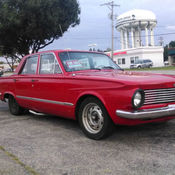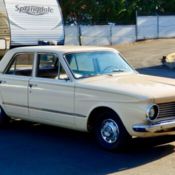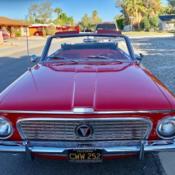1960 Plymouth Valiant Good Driver Rat Rod Stylish Ugly Car Slant 6 Push Button
| Condition: | Used |
| Make: | Plymouth |
| Model: | Valiant |
| SubModel: | V100 |
| Type: | 4 Door |
| Trim: | ?? |
| Year: | 1960 |
| Mileage: | 777,000 |
| VIN: | 1102181859 |
| Color: | Many |
| Engine: | Slant 6 Cylinder |
| Cylinders: | 6 |
| Fuel: | Gasoline |
| Transmission: | Automatic |
| Drive type: | RWD |
| Interior color: | Rough |
| Vehicle Title: | Clear |
| Item location: | Hot Springs, South Dakota, United States |
| Extras |
| Listed by | Private seller |
Description of 1960 Plymouth Valiant ?? |
||
|
1960 Plymouth Valiant Rat Rod Driver Ugly Car 1960 Plymouth Valiant Rat Rod Driver Ugly Car Description Here is what I have to offer the cosmetic condition as shown in pictures [A Little Rough Around The Edges] Car runs and drives good for a 1960 mode, new shocks, new battery, fan bel, been well maintained mechanical Wipers, heater, lights, all working Push button auto trans works fine solid shifts no slipping Rat Rod ? Daily Driver ? Project ? Come on you know you want it !!! Below info from the net As well engineered as it was, there's no doubt that the original 1960 Valiant was one of the weirdest-looking automotive confections ever offered to the public. The Valiant was very zeitgeist Space-Agey-and that's putting it politely. However, at least as early-'60s Virgil Exner designs go, it wasn't that bad, its most ungainly aspect being a C/D pillar angle that's far more-upright than the windshield rake. Other than that, I characterize it as endlessly fascinating to look at, rather than just plain ugly. cats-eye tail lamps and "Toilet Seat" trunk stamp. Call me crazy, call me nerdy. But one of my favorite cars of all time, just to stare at for hours, is the original Valiant. Within a short three years, it would become the definition of the automotive appliance. But for those first three years of its life, Valiant was the wildest peacock of the Big Three compacts.
 Out of the three domestic compacts introduced in the fall of 1959, visually the Valiant had no precedent. The Corvair could reference both roof styles with contemporary large GM hardtops. The Falcon had large afterburner tail lights in common with its larger brethren, except, oddly, in 1960.  Not so much the Valiant. There's clearly elements of Virgil Exner's 1958 Imperial D'elegance concept roller. Despite some of its flat-out details, it's "fuselage" styling, with no break between the bottom of the windows and door upper edge, was very distinct break from tradition, and was first seen in a production car on the Valiant.  But I also see elements of the original Studebaker Champion in the Valiant. Fascinating to me considering Virgil Exner had a hand in designing the original 1939 Champion under Raymond Loewy. Like the Champion, the Valiant was a clean sheet design. Thematically the Champion seemed a spiritual ancestor to the Valiant more so than the dowdy, over engineered Cranbrooks, Cambridges and Concords that were the Plymouth practical bread and butter in the early 1950s.  But the Valiant continued to display Chrysler's long established reputation for engineering prowess. It was also one of the first cars designed using computers. The taut "Torsion-Aire" suspension, the easy to use pushbutton TorqueFlite, and the seemingly indestructible Slant 6 were attached to its unit body. Special care was paid to sound deadening and vibration control to make the Valiant seem less removed from a larger, more traditional mid century American Sedan.  It rode the second shortest wheelbase in it's class (106.5 inches) but at 184.5 inches long it was almost 10 inches longer than a Lark. The interior afforded more leg room than either Falcon or Corvair. Also, reflecting its higher entry price the interior wasn't as spartan as a standard Falcon or Corvair 500.  According to Allpar the Valiant almost ended up a lot like the Corvair. The Slant 6 started as a Slant 4 mounted out back, but didn't produce enough torque for American tastes and was soon upsized to a six. The stories from the GM proving grounds scared Chrysler engineers to approach their interpretation of the "rationalization" of the American sedan from a more traditional stance. The slant six was named such because of its 30 degree angle slant towards the passenger side of the car.  Due to its longer intake runners and other engineering tricks, it was a superior performer to a majority of the six cylinders offered by competitors. At 101 standard horsepower, the 170 cube version ran 0-60 times in the 15-17 second range (depending on which source), which put it a 3-4 seconds ahead of the Corvair, and up to 9-10 seconds ahead of a dawdling Falcon wheezing through it's 144 Six and a Ford-O-Matic. The Hyper Pak equipped versions shamed the Corvair and Falcon in a special compacts only 1960 Daytona 500 event. The Valiants took the first Seven positions in the race. On the second day, the first place Valiant averaged 122mph. So, if the original Valiant was so superior at everything, why was it the (seemingly) most unloved of the first Big Three compacts? Although it sold 194, 000+ units in its first year, that trailed the Corvair's 250,000 or the 435,000+ Falcons that spewed like ants out of Ford factories throughout the nation. In 1961 and 1962 the sales stayed pretty much steady, never really breaking out of the 150K range. The main reason I can attribute is the curious styling.  The original Valiant looks like nothing that came out of American design studios at the time. There's a lot of classic design elements trying to break through. The front fender brow hints at trying to have a separate fender look, as does the radius curve around the rear wheel that flows into the slanted fins.  It gives the upper body structure of the 2 door Valiants a rather pregnant look compared to the smooth taper of the Corvair, or the faux pretense of a Falcon Futura 2 door with its square C pillars cribbed from the Thunderbird. The reason was a cost saving measure, so all Valiant non-wagons could use the same roof stampings and door/window parts.  Another curious throwback of the Valiant design is how far the passenger cabin sits above the fender line. In contrast to even with the beltline design of almost every other American car of the period, the Valiant harkens back to a school of design that says that says film noir more than Fellini. It's very retro modern in that way. And perhaps details like these hampered its appeal.  But, the Valiant has a fan in me. And my favorite element of the original Valiant has to be its fantastic face. It's the most complete face out of all of the American Compacts on offer in original form. The Corvair's face didn't look quite right until the 1961 nose surgery that gave it more cargo capacity. The Falcon looked decidedly unfinished and cheap with its 1960-61 face.  I know it's pretty much is a downsized form of a Chrysler 300 Letter series front end. It's not a "pretty" face. It's a rather masculine look. But the detail involved with making such an expressive visage gives the Valiant a premium look that contemporaries could not match. Click images to enlarge
Track Page Views With Auctiva's FREE Counter |
 Home
Home Contact us
Contact us NEWEST CARS
NEWEST CARS SELL YOUR CAR
SELL YOUR CAR FAQ
FAQ







